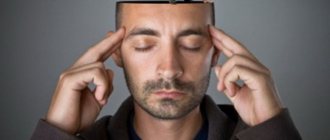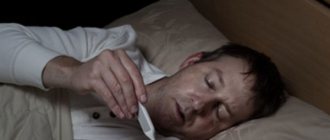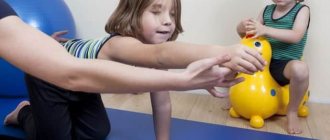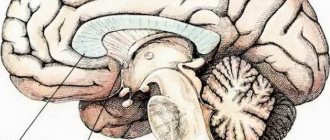Author's rating
5
Author of the article
Daria Polevaya
Practicing general practitioner with 7 years of experience. I love my job and try to constantly improve my skills.
Articles written
34
Sleep disorders in children are not uncommon, and one of them is sleepwalking. Sleepwalking children make parents worry and frighten, but in fact in most cases the threats and risks are minimal. And yet, mothers and fathers need to find out the reasons for sleepwalking and think through tactics of behavior when the disorder manifests itself.
What is sleepwalking?
Sleepwalking in scientific medical language is called somnambulism; from Latin the word is translated as “sleepwalking”, “sleepwalking”. In the ICD (International Classification of Diseases), the disorder refers to sleep disorders - parasomnias. Sleepwalking is regarded as a form of being in an altered state of consciousness, in which periods of wakefulness and sleep are combined.
Human sleep is a complex process. Night rest is divided into several cycles, each including two phases: slow and fast. With the latter, muscle tone changes, chaotic spontaneous movements of the limbs and eyeballs occur. In the slow phase, the body is relaxed, and it is not easy to wake up the sleeper. And it is at this time that signs of sleepwalking may appear, although it may occur during REM sleep. Episodes are more often observed in the first half of the night - 1-1.5 hours after falling asleep.
Sleepwalking is common: systematic manifestations are observed in 5% of children. 30% experienced single episodes or multiple episodes. The first signs are detected at 4-6 years, but somnambulism is possible at 2-3 years and earlier. Usually, by late adolescence, somnambulism disappears independently and completely, but there are exceptions. Symptoms persist and remain severe in only 1% of adults.
Good to know! Another variant of the disorder is sleep-speaking, which occurs during the transition between sleep and wakefulness. The fundamental difference is the absence of full movements: the child can talk, but usually does not get out of bed.
Progression of the attack
Attentive parents know what their child looks like when he sleepwalks at night. Somnambulists walk around the apartment with wide-open eyes and a detached face. At the same time, they can dress, play, and collect a briefcase. Sometimes the attack ends suddenly. Then children sleep sitting or lying on the floor. In the morning they wonder how they ended up in another place, since they don’t remember anything.
It is impossible to wake a child during sleepwalking. He may get scared and develop neurotic conditions.
In adolescents, somnambulism can occur until the age of 16. It proceeds with speaking and performing actions. It is important to monitor children so that they do not accidentally injure themselves. There have been cases when, in a state of sleepwalking, a teenager ended up on the roof of a house and jumped out of a window.
If piercing or cutting objects come into your hands during the period of somnambulism, the sleepwalker will receive injury or inflict it on loved ones who happen to be nearby. Signs of parasomnia disappear at the age of 12-16 years. In adulthood, the disorder is less common and is associated with mental disorders. Then you will need to contact a psychiatrist or neurologist.
No link 1
Why do some children sleepwalk at night?
The causes of sleepwalking have not been fully studied and are unknown, but the mechanism of development of the disorder is based on disruptions in the inhibition processes in the central nervous system. Normally, their action should affect all parts of the brain, but the areas responsible for coordinating motor functions are untouched or are not sufficiently inhibited. As a result, some parts of the brain go into a resting state and turn off, while others remain awake, causing the body to move. This is probably due to the fact that the children's nervous system is not fully formed and does not work at full capacity.
For your information! A commentary by pediatrician Evgeniy Komarovsky confirms that the causes of sleepwalking in children are unknown, but the disorder is often inherited. There is no special therapy, but sleepwalking goes away on its own by adolescence.
Surveys
An examination for suspected somnambulism is mandatory and should contain the following procedures and measures:
- MRI of the brain, as well as computed tomography.
- EEG (electroencephalography).
- Ultrasound of the brain.
- Polysomnography in the laboratory.
After analyzing the results, the specialist must conclude that it is necessary to prescribe medications, other treatment, or it is enough to just adjust the daily routine of the child or teenager in order to normalize the processes occurring in the nervous system.
Risk factors
Risk factors that increase the likelihood of sleepwalking in a child:
- Experienced stress, shock, psychological trauma. They affect the nervous system and disrupt its functioning.
- Traumatic brain injuries can damage parts of the brain responsible for motor functions.
- Genetic predisposition. American scientists managed to discover a part of the 20th DNA chromosome that contributes to the occurrence of somnambulism. If the site is present, the risks increase by 1.5 times, although the specific gene has not yet been identified. But if two parents suffered from somnambulism, the likelihood of the child inheriting the disorder reaches 55-60%.
- Other sleep disorders: insomnia, nightmares, increased duration of rest at night (hypersomnia).
- The reaction of a teenager or small child to conflicts with peers, quarrels or divorce of parents, strict punishments, global changes in life (moving, changing kindergarten or school).
- Neurological disorders, such as neurosis.
- The child’s stay in unfavorable conditions, a tense environment.
- Intense loads, constant overwork when studying at school, attending extra classes or clubs.
- Increased emotionality, vulnerability of the child.
- Non-compliance with the daily routine: late bedtimes, lack of daytime rest at an early age.
- Taking medications: antihistamines, tranquilizers, antipsychotics.
- Recent general anesthesia.
What is the seriousness and danger of the disease?
In the world, about 2% of the population has ever walked in their sleep, and among children this statistics is much higher (the only plus is that children’s sleepwalking usually goes away with age and is not dangerous).
If such a story is observed in an adult, then close attention should be paid to his health. Somnambulism can be caused by neuroses and other types of nervous system disorders. People who are overly emotional or have a genetic predisposition to this problem can become sleepwalkers.
It is important to pay attention to the problem in time, since sleepwalking can often be a harbinger of a developing disease - epilepsy. Moreover, sleepwalking can be observed several years before the first attacks and other symptoms of the disease.
Although most often, from a health point of view, sleepwalking does not pose a danger. This problem is more terrible because in 25% of cases a person injures himself and others. There are cases of murder in such a state, but the somnambulist will not remember anything in the morning, since this happens in the unconscious. Fortunately, such terrible cases occur extremely rarely.
The consequences of sleepwalking consist mainly of various types of injuries. Although the movements of a sleepwalker seem logical, they do not control themselves, and therefore can harm themselves.
Every parent should know what to do if a child sleepwalks. This is primarily due to the fact that children do not control themselves during this period. Therefore there is a risk of injury. The baby may go outside, open a window, hit himself, cut himself, or break something.
Sleepwalking carries potential danger. In certain situations, the consequences of somnambulism are disastrous. After all, in an unconscious state, a child can commit the most unpredictable actions. There was a recorded case where a little sleepwalker cut his hands.
In addition, the condition indicates disturbances in the functioning of the brain. This cannot be ignored. Often, somnambulism is not caused by pathological changes. However, it is mandatory to undergo an examination.
Sleepwalking is a harmless “disease”; it does not harm the body unless it is a sign of epilepsy.
Somnambulism poses a danger primarily due to the injuries that a child can unintentionally inflict on himself or the people around them:
- A child may leave home and freeze or get hit by a car;
- In 25% of cases of sleepwalking, people harm themselves. This is how a case was recorded when a sleepwalking child cut his hands with a knife in his sleep. A somnambulist can fall out of an open window, climb onto the roof and fall from it;
- Rarely, but there are cases of aggression from a sleepwalker towards people around him. Aggressive behavior occurs due to a nightmare (the child dreams that he is surrounded by monsters) or as a response to rude attempts to wake him up. One day, the little girl attacked her own father, who seemed like a monster to her in a dream. Another girl tried to hit her mother with a heavy object. Usually, aggression during sleepwalking does not cause significant harm to health, but history has recorded cases of murders committed by sleepwalkers in their sleep: the murder of parents, children, spouses. So one day a teenage girl shot her father;
- Sleepwalking may be the first manifestation of impending epilepsy or other serious health and mental problems.
Diseases that may be accompanied by sleepwalking
Sleepwalking can be a consequence of the following diseases:
- epilepsy;
- parasitic infestations;
- gastroesophageal reflux with episodes of severe nocturnal heartburn, causing discomfort and waking up;
- asthma;
- obstructive sleep apnea syndrome (involuntary pauses in breathing during sleep);
- diseases of internal organs of a chronic nature, symptoms of which may often appear at night;
- previous neuroinfections (encephalitis, meningitis, borreliosis, myelitis, tetanus, leptospirosis).
Therapy
To combat this disorder, hypnotic practices or work with a psychologist are used. The first method is practiced when the baby regularly walks in his sleep and gets injured. Consultations with a psychologist are needed when the cause of the disorder is considered to be neurosis or stress. Medicines are used in rare situations.
Treatment of concomitant disorders that provoke sleepwalking is often carried out. Thus, during epilepsy, anticonvulsants may be prescribed. If a child experiences stress and nervousness, he is given antidepressants. When attacks of aggression develop, medications that strengthen general health and sedatives are prescribed.
Manifestations of sleepwalking
The symptoms are similar, but have differences depending on the characteristics of the individual child. Some children sit up in bed, others begin to walk. The somnambulist is able to leave the room and walk around the house or apartment; there are known cases of leaving the home and walking to neighboring areas. But more often walking is limited to one room. There are often monotonous, automatic actions that are performed periodically during the day: putting on clothes, putting on shoes, going to the toilet, washing, brushing teeth, cleaning.
In sleepwalkers, during episodes of sleepwalking, the eyes are open and the pupils are constricted. The gaze is absent, unfocused, as if “glassy”. The child does not see anything, the baby can walk straight into surrounding objects, bump into them, stumble, or fall. At these moments, the somnambulist may have dreams.
Another sign of somnambulism is speaking. But the speech is incoherent, many words are incomprehensible. If you start a conversation with a sleepwalker, he will answer questions inappropriately or completely ignore them, say isolated sounds or repeat simple words. The ability to communicate and respond adequately to requests is lacking. The teenager is able to begin to tell stories and describe the events that happened.
It is not easy to wake up a somnambulist, and if he wakes up, he will be in a confused, disoriented, and inadequate state. A teenager may start talking rudely, and a small child may start yelling, crying, and rushing around the room. There is no need to shout at the sleepwalker and try to shake him, bringing him to his senses. The best option is to calm him down, stop the crying and calmly and carefully take him to bed to continue sleeping.
The duration of one episode of sleepwalking varies from ten to fifteen minutes to 1-1.5 hours. In rare cases, a sleepwalker walks half the night or during the entire period of night rest.
Symptoms of somnambulism
A sleepwalker wanders around the apartment at night, approaches sleeping relatives, and sits motionless in bed. Some perform complex actions: looking for something, playing with toys, playing music.
Sometimes somnambulists open the door and leave the apartment dressed or barefoot. Common features include:
- Unconsciousness of the movements performed - they are not controlled by the brain centers, they resemble a robot. A sleepwalker cannot wake up and talk (sometimes he mutters something), and the instinct of self-preservation is severely impaired in children and adolescents. They are not responsible for their actions in a dream.
- “Absent” facial expression - the eyes are constantly open, the pupils are narrowed. Facial muscles do not work, so emotions do not appear.
- Some children have their eyes closed, but walk or make other movements confidently.
- Complete loss of memory about what is happening in a dream. Children express distrust of people who talk about their recent adventures.
How should parents behave?
When your child starts sleepwalking, there is no need to panic. If done correctly, the episodes will become less pronounced, short-lived and infrequent. Recommendations for parents:
- Make the children's room as safe as possible: clear it of furniture with sharp corners, remove dangerous objects, put locks or covers on the windows.
- In a multi-storey cottage, the child’s room should not be on the first floor to avoid accidental falls from the stairs.
- Provide doors with bells to wake up when the child leaves the room and control his actions.
- Close the front door with several locks: in a sleepy state, a sleepwalker will not be able to open it.
- Create a favorable, calm atmosphere for healthy sleep: close the windows with thick curtains, avoid loud sounds, and ventilate the nursery.
- Do not laugh at someone suffering from somnambulism, do not reproach him: he should feel supported and know that he is completely normal.
- If episodes begin to occur more frequently, try to identify and eliminate the reasons for the worsening condition.
- The struggle presupposes the normalization of emotional and psychological states, so be more restrained, talk to your son or daughter, and be interested in life.
- If the child begins to get sick with fever and fever, stabilize the condition to prevent more frequent attacks of somnambulism.
Diagnostics
The specialized physician whose competence includes the assessment and treatment of sleep disorders is a sleep physician. As a rule, when making a diagnosis related to sleepwalking, this specialist relies on the description of the child’s behavior by relatives/close ones.
It is important to conduct a comprehensive physical and psychological examination to exclude other conditions that provoke manifestations of sleepwalking. If such a disorder is detected, then somnambulism is eliminated by treating the underlying pathology.
Sometimes polysomnography is performed to identify the full range of disorders accompanying the sleep period (for example, apnea)..
Polysomnography is a complex and often lengthy procedure, which, however, is completely painless. During this examination, the child spends at least one night in a special laboratory.
Multiple electrodes are attached to different parts of the patient's body to measure heart rate, brain wave patterns, breathing rate, muscle tension, eye and leg movements, and blood oxygen levels. In addition, video recording is being carried out. Sometimes several sessions of polysomnography are required.
Another diagnostic method combined with treatment of the disorder is planned awakening . It consists of monitoring the child for several nights. This allows us to determine the period usually corresponding to manifestations of sleepwalking. Then the child is woken up 15 minutes before the intended somnambulism session. This approach allows you to reboot the existing sleep cycle and control the behavior of the sleepwalker.
Treatment
It is completely impossible to cure somnambulism, but this disorder tends to go away on its own, without intervention. If episodes of sleepwalking do not cause alarm and do not threaten the health and life of the child, then active action is not necessary, but it is advisable to consult a doctor. A visit to a neurologist is recommended: he will conduct an examination and rule out serious neurological diseases. You can show the child to a psychologist, whose advice will allow parents to understand their offspring, help him normalize his psychological state and reduce manifestations to nothing. In difficult situations (psychological trauma), a visit to a psychiatrist is indicated.
If episodes are frequent and dangerous for the child, it is worth starting treatment. The doctor may recommend a sedative, and in extreme cases, for neurological disorders, antidepressants and benzodiazepines are prescribed. But these are powerful prescription drugs prescribed by specialists!
New experimental methods of treatment include hypnosis, but in some cases it not only does not allow one to get rid of sleepwalking, but also has an extremely negative effect on the fragile child’s psyche.
Which doctor should I contact?
If you notice symptoms of sleepwalking or signs that suggest a tendency toward somnambulism, visit a pediatric neurologist. A good help in eliminating unpleasant symptoms is observation by a psychotherapist or psychologist.
Doctors will help you find out the cause of the problem, tell you how to act to protect children from stressful situations, and eliminate factors that provoke sleepwalking.
Note! Untested, pseudoscientific methods of therapy, the use of dubious methods, and inappropriate folk recipes are harmful.
Traditional methods
As home folk remedies, use decoctions of plants that have a calming effect: linden, lemon balm, mint, hops, chamomile. Warm milk with honey before bed is beneficial. Aromatherapy is effective: essential oils of lavender, ylang-ylang, incense, jasmine.
Try the sleepwalking spell, which helps some, if you believe the reviews on the forums. Take a moonstone and say the phrase on it: “Stop nightlife, sublunary conversations, sleepy walks! Let it be so!". The plot is spoken ten times, and the stone is placed under the sleeping person’s pillow before going to bed.
Prevention
Measures to prevent and prevent somnambulism:
- Stick to a daily routine: the child should fall asleep and wake up at the same time. Follow age-appropriate sleep standards.
- Before going to bed, limit outdoor games, stress, and violent emotions. Classes should be calm and quiet.
- Let's have a light snack an hour or two before bed: a glass of kefir, a vegetable salad, a piece of boiled fish.
- Do not allow the sleepwalker to watch TV, play computer games, or use a smartphone for entertainment purposes in the evening. The glare and blinking of the monitor irritate the psyche.
- Ventilate the bedroom before going to bed, curtain the windows, humidify the air if the humidity is low.
- Monitor the atmosphere in the family: avoid quarrels in front of the child, do not raise your voice, resolve all issues peacefully.
- The child should be in the fresh air more often, take more walks, and receive positive emotions.
There are many videos on the topic discussed, but from this article you learned a lot about how to detect and treat sleepwalking in children. It is not always necessary to fight somnambulism; sometimes a wait-and-see approach is advisable. If symptoms persist and worsen, you will need medical help. Equally important is the correct behavior of parents, which will help the child accept the problem and feel comfortable.
general information
Sleepwalking falls into the category of somnambulism or sleepwalking. During this disorder, a sleeping person manages to exhibit motor activity at night, characteristic of a certain phase of sleep. He can sit on the bed, move around the room, and do something with objects. In some situations, such activity leads to injury or death, but such things happen rarely.
Sleepwalking is related to some types of parasomnia disorders. Conditions such as paralysis, nightmares, enuresis, etc. are related to this category. talking about dreams can also relate to parasomnia.
About 15% of the world's population have sleepwalked at least once in their lives. Regular examples of somnambulism are found in 2.5% of the population. Therefore, this condition cannot be classified as a rare mental disorder.
Before electricity was invented, the moon was the only source of illumination at night that affected sleepwalking habits. Most often, sleepwalking is diagnosed in children aged 4 to 8 years, and is rarely caused by complex pathological processes.












